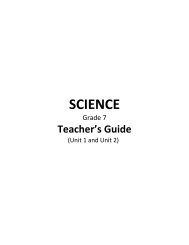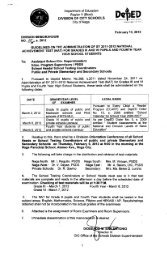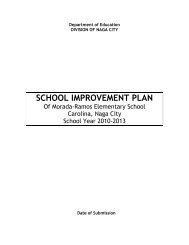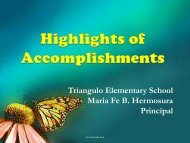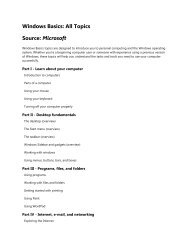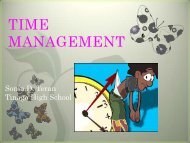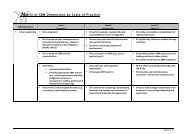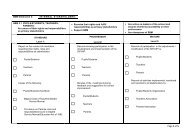Setting the OL Trap - DepEd Naga City
Setting the OL Trap - DepEd Naga City
Setting the OL Trap - DepEd Naga City
You also want an ePaper? Increase the reach of your titles
YUMPU automatically turns print PDFs into web optimized ePapers that Google loves.
Objective<br />
• General<br />
‣ Provide <strong>the</strong> scientific framework of <strong>the</strong> <strong>OL</strong><br />
<strong>Trap</strong> Program of Dengue vector control<br />
UITO <strong>OL</strong>-TRAP<br />
15 June 2012 DOST School-based O/L <strong>Trap</strong> Program<br />
2
Objective<br />
UITO <strong>OL</strong>-TRAP<br />
• Specific<br />
‣ Explain <strong>the</strong> concept of vector control<br />
‣ Explain dengue vector control<br />
‣ Explain Integrated Vector Control (IVC) and<br />
Integrated Vector Management (IVM)<br />
‣ Discuss <strong>the</strong> components of IVC from vector<br />
biology to control measures<br />
15 June 2012 DOST School-based O/L <strong>Trap</strong> Program<br />
3
Objective<br />
• Specific<br />
‣ Describe vector surveillance as it applies to<br />
dengue <strong>OL</strong> <strong>Trap</strong> in a classroom setting<br />
‣ Answer <strong>the</strong> fourteen questions enumerated<br />
in <strong>the</strong> situationer<br />
UITO <strong>OL</strong>-TRAP<br />
15 June 2012 DOST School-based O/L <strong>Trap</strong> Program<br />
4
Objective<br />
UITO <strong>OL</strong>-TRAP<br />
• Specific<br />
‣ Identify <strong>the</strong> following<br />
• Mosquito eggs in a lawanit paddle<br />
• Ovitrap (black tumbler and paddle)<br />
• Mosquito larva<br />
• Pupae<br />
• Positive/negative trap<br />
• Adults<br />
• Entomological forms (Ovitrap/<strong>OL</strong> <strong>Trap</strong>)<br />
• Pellets<br />
15 June 2012 DOST School-based O/L <strong>Trap</strong> Program<br />
5
Situationer<br />
UITO <strong>OL</strong>-TRAP<br />
• Urban / semi-urban setting<br />
• Big public elementary school in <strong>City</strong> “X”<br />
• 3-story building (~30-35 feet)<br />
• 10 classrooms per floor 16x20 feet per<br />
room)<br />
• 50-55 pupils occupy one classroom from<br />
8am-5pm<br />
15 June 2012 DOST School-based O/L <strong>Trap</strong> Program<br />
6
Situationer<br />
UITO <strong>OL</strong>-TRAP<br />
• ~ 1,200-1,500 pupils<br />
• No electric fans in <strong>the</strong> classrooms<br />
• One aircon and/or electric fan at<br />
principal’s office<br />
• Houses near <strong>the</strong> school<br />
• Presence of flower vases, water<br />
containers<br />
Click Here<br />
15 June 2012 DOST School-based O/L <strong>Trap</strong> Program<br />
7
Questions<br />
UITO <strong>OL</strong>-TRAP<br />
• How many ovitraps/<strong>OL</strong> <strong>Trap</strong>s are<br />
needed to be installed in <strong>the</strong><br />
elementary school<br />
• Where should <strong>the</strong> traps be installed<br />
• When should <strong>the</strong> traps be installed<br />
• How frequent should <strong>the</strong> traps be<br />
installed<br />
15 June 2012 DOST School-based O/L <strong>Trap</strong> Program<br />
8
Questions<br />
UITO <strong>OL</strong>-TRAP<br />
• What is <strong>the</strong> procedure to be followed in<br />
installing <strong>the</strong> traps In servicing <strong>the</strong><br />
traps What is <strong>the</strong> meaning of servicing<br />
<strong>the</strong> traps<br />
• Who will install and service <strong>the</strong> traps<br />
15 June 2012 DOST School-based O/L <strong>Trap</strong> Program<br />
9
Questions<br />
UITO <strong>OL</strong>-TRAP<br />
• Who will monitor and check <strong>the</strong> traps<br />
‣ Monitor<br />
• Empty tumbler<br />
• Missing tumbler/paddle<br />
‣ Check<br />
• If positive/negative<br />
• Is <strong>the</strong>re a form to be filled-out<br />
15 June 2012 DOST School-based O/L <strong>Trap</strong> Program<br />
10
Questions<br />
UITO <strong>OL</strong>-TRAP<br />
• What index needs to be obtained<br />
• What formula is to be used<br />
• What is <strong>the</strong> meaning of <strong>the</strong> index<br />
obtained<br />
• Who will record and compute for <strong>the</strong><br />
index<br />
15 June 2012 DOST School-based O/L <strong>Trap</strong> Program<br />
11
Questions<br />
• To whom should <strong>the</strong> data be submitted<br />
to Why<br />
• For how long will this ovitrapping be<br />
done<br />
UITO <strong>OL</strong>-TRAP<br />
15 June 2012 DOST School-based O/L <strong>Trap</strong> Program<br />
12
What’s inside<br />
• Vector<br />
• Surveillance<br />
• Prevention and Control<br />
UITO <strong>OL</strong>-TRAP<br />
15 June 2012 DOST School-based O/L <strong>Trap</strong> Program<br />
13
Vector<br />
UITO <strong>OL</strong>-TRAP<br />
• An arthropod (insects, mites, ticks) that<br />
are capable of: acquiring, supporting<br />
<strong>the</strong> development and transmitting a<br />
pathogenic agent (bacteria, viruses,<br />
parasites) from one host to ano<strong>the</strong>r<br />
host<br />
Example: mosquito Aedes sp.<br />
transmitting dengue virus<br />
15 June 2012 DOST School-based O/L <strong>Trap</strong> Program<br />
14
Vector Control<br />
• suppression of a target population by<br />
using measures to alter <strong>the</strong> vector<br />
reproductive capacity or potential (Vector<br />
Genetics Course, 2010, India)<br />
UITO <strong>OL</strong>-TRAP<br />
15 June 2012 DOST School-based O/L <strong>Trap</strong> Program<br />
15
Dengue Vector Control<br />
• Application of various anti-DEN<br />
mosquito measures to alter <strong>the</strong> life<br />
cycle of <strong>the</strong> mosquito<br />
UITO <strong>OL</strong>-TRAP<br />
15 June 2012 DOST School-based O/L <strong>Trap</strong> Program<br />
16
Dengue Vector Control<br />
UITO <strong>OL</strong>-TRAP<br />
• Specific Targets<br />
‣ Prevent and cut dengue transmission by:<br />
• Targeting larval stage through<br />
<strong>Trap</strong>ping<br />
Larviciding<br />
Container management<br />
Environmental sanitation<br />
15 June 2012 DOST School-based O/L <strong>Trap</strong> Program<br />
17
Dengue Vector Control<br />
UITO <strong>OL</strong>-TRAP<br />
• Specific Targets<br />
‣ Prevent and cut dengue transmission by:<br />
• Targeting adult stage through<br />
Adulticiding<br />
» Space-spraying<br />
» Aerosol treatment<br />
Genetic manipulation of<br />
reproductive capacity of mosquito<br />
15 June 2012 DOST School-based O/L <strong>Trap</strong> Program<br />
18
Dengue Vector Control<br />
UITO <strong>OL</strong>-TRAP<br />
• Specific Targets<br />
‣ Prevent and cut dengue transmission by:<br />
• Prevention of man-mosquito contact<br />
curtains<br />
Screening of doors and windows<br />
Long pants<br />
Repellants<br />
15 June 2012 DOST School-based O/L <strong>Trap</strong> Program<br />
19
Integrated Vector Control<br />
• Combination of 2 or more vector<br />
control activities supplementary to<br />
each o<strong>the</strong>r towards reduction of<br />
dengue incidence<br />
UITO <strong>OL</strong>-TRAP<br />
15 June 2012 DOST School-based O/L <strong>Trap</strong> Program<br />
20
Integrated Vector Management<br />
UITO <strong>OL</strong>-TRAP<br />
• utilization of technical and managerial<br />
measures to bring about an effective<br />
degree of vector suppression<br />
to prevent and control<br />
transmission<br />
15 June 2012 DOST School-based O/L <strong>Trap</strong> Program<br />
21
Components of IVC<br />
UITO <strong>OL</strong>-TRAP<br />
• Vector biology/behavior<br />
• Surveillance tool (Ovitrap/<strong>OL</strong> <strong>Trap</strong><br />
surveillance index)<br />
• Critical Threshold Density Index<br />
(effective degree of vector suppression<br />
[Ovitrap index]<br />
• Control Measures<br />
• Monitoring and evaluation<br />
15 June 2012 DOST School-based O/L <strong>Trap</strong> Program<br />
22
The Vector<br />
UITO <strong>OL</strong>-TRAP<br />
15 June 2012 DOST School-based O/L <strong>Trap</strong> Program<br />
23
Vector Biology<br />
Aedes aegypti<br />
Aedes albopictus<br />
General<br />
characteristics<br />
- primary vector<br />
- involve in cases of<br />
epidemics<br />
- urbanized areas<br />
- lives indoors<br />
- secondary vector<br />
- maintains <strong>the</strong> virus in<br />
<strong>the</strong> environment<br />
- rural areas<br />
- lives outdoors<br />
UITO <strong>OL</strong>-TRAP<br />
Breeding habitat<br />
- confined to artificial<br />
containers indoors<br />
- prefers to breed<br />
outdoor, in natural<br />
containers<br />
Resting habits<br />
- rests in cool, dark<br />
corners of <strong>the</strong> house<br />
- rests outdoors in<br />
clearings and<br />
vegetations<br />
15 June 2012 DOST School-based O/L <strong>Trap</strong> Program<br />
24
Morphology<br />
Aedes aegypti<br />
Aedes albopictus<br />
Size - 3-4 mm - same<br />
Color - dark brown to black - same<br />
Thorax<br />
- lyre-shaped white<br />
marks or scales<br />
- single white marks<br />
UITO <strong>OL</strong>-TRAP<br />
Abdomen<br />
- with white scales<br />
- with white and dark<br />
marks<br />
Legs - with white marks - same<br />
15 June 2012 DOST School-based O/L <strong>Trap</strong> Program<br />
25
Vector Characteristics<br />
UITO <strong>OL</strong>-TRAP<br />
• Biting Habits<br />
‣ “daybiters” with two peaks of biting time:<br />
• 1 to 2 hours after sunrise<br />
• 1 to 2 hours before sunset<br />
‣ only female mosquitoes bite because of <strong>the</strong><br />
requirement of blood for oviposition<br />
‣ males do not bite but feed on plant juices<br />
and nectar of flowers<br />
‣ man is <strong>the</strong> preferred host but<br />
in his absence, lower<br />
vertebrates serve as substitute<br />
15 June 2012 DOST School-based O/L <strong>Trap</strong> Program<br />
26
Vector Characteristics<br />
UITO <strong>OL</strong>-TRAP<br />
• Flying Habit<br />
‣ do not fly great distances<br />
‣ far<strong>the</strong>st flight distance is within 200 to 400<br />
meters radius from <strong>the</strong>ir breeding places<br />
• Adults found around 50 meters from<br />
<strong>the</strong> breeding sources<br />
15 June 2012 DOST School-based O/L <strong>Trap</strong> Program<br />
27
Bionomics<br />
UITO <strong>OL</strong>-TRAP<br />
• at temperatures 40 o C, no<br />
developmental process takes place<br />
• females mates with male only once<br />
• Blood meal takes place after<br />
48 hours from emergence and<br />
after mating for egg<br />
production<br />
15 June 2012 DOST School-based O/L <strong>Trap</strong> Program<br />
28
Bionomics<br />
UITO <strong>OL</strong>-TRAP<br />
• oviposition takes place about 2 to 5<br />
days from blood engorgement<br />
• prefers dark-colored background for<br />
oviposition<br />
• lays egg 3 to 4 times in its lifetime<br />
‣ 60 to 100 eggs per batch<br />
• Survival potential: 20-30 days<br />
15 June 2012 DOST School-based O/L <strong>Trap</strong> Program<br />
29
Life Cycle (10-12 days)<br />
Adult<br />
-Maxillary pulps<br />
shorter than probosis<br />
-Wings uniformly<br />
grayish black<br />
-Body and legs are<br />
black with distinctive<br />
white patches<br />
throughout<br />
-Thorax has<br />
markings<br />
Eggs:<br />
- Black and oval in<br />
shape<br />
- Laid singly above<br />
water surfaces of<br />
containers<br />
- Without float<br />
- Viability: 6 months<br />
to 1 year due to<br />
<strong>the</strong> presence of<br />
chorion<br />
UITO <strong>OL</strong>-TRAP<br />
Pupa<br />
-Non-feeding stage<br />
-Breeding trumpet is<br />
long, slender with<br />
narrow opening<br />
1 - 2 days<br />
6 - 8 days<br />
2 - 3 days Larva:<br />
- Feeding stage<br />
- Breeds in clean and<br />
non-polluted water<br />
- Short and stout<br />
siphon with one pair<br />
of hair tuft<br />
- Rests at an angle to<br />
<strong>the</strong> water surface<br />
15 June 2012 DOST School-based O/L <strong>Trap</strong> Program<br />
30
Surveillance<br />
UITO <strong>OL</strong>-TRAP<br />
15 June 2012 DOST School-based O/L <strong>Trap</strong> Program<br />
31
Vector Surveillance<br />
UITO <strong>OL</strong>-TRAP<br />
• Collection and interpretation of data<br />
which can be used to guide mosquito<br />
vector control operations<br />
• Establish baseline<br />
• Presence or absence of vector<br />
‣ Species<br />
‣ Density<br />
‣ Changes<br />
15 June 2012 DOST School-based O/L <strong>Trap</strong> Program<br />
32
Dengue Surveillance Tool<br />
UITO <strong>OL</strong>-TRAP<br />
• Classical OVITRAP/LARVITRAP<br />
(black tumbler, paddle, water)<br />
• Modified OVITRAP is <strong>the</strong> <strong>OL</strong>TRAP<br />
(black container, paddle,<br />
water and organic<br />
larvicide)<br />
• 2 adults (females)<br />
emerging per day<br />
(Malaysian experience)<br />
15 June 2012 DOST School-based O/L <strong>Trap</strong> Program<br />
33
Difference between tools<br />
Ovitrap<br />
<strong>OL</strong> <strong>Trap</strong><br />
Eggs on <strong>the</strong> paddle - Yes - Yes<br />
Live larva seen - Yes - No<br />
Action - Eggs trapped - Eggs trapped<br />
With organic larvicide<br />
Value-added<br />
- None<br />
- None<br />
- Yes<br />
- Additional attractant<br />
(kills larva)<br />
UITO <strong>OL</strong>-TRAP<br />
Risk - with white marks - same<br />
Benefit<br />
- Breeds Aedes, if<br />
uncollected (set and<br />
collect)<br />
- Breeds Aedes, if<br />
uncollected after 7<br />
days (set and collect)<br />
Index (CTDI) - Ovitrap index : 10% - <strong>OL</strong><strong>Trap</strong>: 10%<br />
15 June 2012 DOST School-based O/L <strong>Trap</strong> Program<br />
34
Ovitrap Index<br />
Total Number of positive traps<br />
Total Number of traps planted<br />
X 100%<br />
UITO <strong>OL</strong>-TRAP<br />
If OI is >10%, <strong>the</strong> place is vulnerable to<br />
dengue transmission.<br />
15 June 2012 DOST School-based O/L <strong>Trap</strong> Program<br />
35
Critical Threshold Density Index<br />
(CTDI)<br />
• Actual target for <strong>the</strong> degree of vector<br />
suppression<br />
• Predictive value for <strong>the</strong> prevention of<br />
dengue transmission<br />
UITO <strong>OL</strong>-TRAP<br />
15 June 2012 DOST School-based O/L <strong>Trap</strong> Program<br />
36
Remember:<br />
UITO <strong>OL</strong>-TRAP<br />
• A positive trap means <strong>the</strong>re is at least<br />
one mosquito laying its eggs in <strong>the</strong><br />
sampling site (surveillance site)<br />
• Aim is eliminate this one mosquito<br />
laying its eggs<br />
15 June 2012 DOST School-based O/L <strong>Trap</strong> Program<br />
37
What is DOST Mosquito Ovi/Larvicidal<br />
(<strong>OL</strong>) <strong>Trap</strong> System<br />
• Is a system used to control <strong>the</strong> population of <strong>the</strong><br />
dengue carrying Aedes mosquitoes.<br />
• It has three important parts: a black container, a<br />
small strip of lawanit measuring 1” x 6.5” for<br />
mosquitoes to lay <strong>the</strong>ir eggs on, and pellets as<br />
larvicide.<br />
Tumbler<br />
UITO <strong>OL</strong>-TRAP<br />
•The <strong>OL</strong>-<strong>Trap</strong>’s ovicidal and larvicidal effect<br />
prevent <strong>the</strong> next generation of mosquitoes from<br />
reaching adulthood, thus curbing <strong>the</strong> Aedes<br />
mosquito population.<br />
Paddle<br />
Pellets<br />
15 June 2012 DOST School-based O/L <strong>Trap</strong> Program<br />
38
HOW THE <strong>OL</strong>-TRAP WORKS<br />
• The idea is to attract mosquitoes particularly <strong>the</strong><br />
Aedes aegypti and albopictus (dengue carrier) to lay<br />
<strong>the</strong>ir eggs on <strong>the</strong> lawanit paddle.<br />
• The trap creates optimum conditions for this species<br />
to lay its eggs: stagnant, clean, clear water, dark<br />
area and damp rough surface.<br />
UITO <strong>OL</strong>-TRAP<br />
15 June 2012 DOST School-based O/L <strong>Trap</strong> Program<br />
39
• The eggs will ei<strong>the</strong>r be trapped in <strong>the</strong> lawanit paddle<br />
or find its way into organic solution, where <strong>the</strong>y are<br />
killed before transforming into adults.<br />
Eggs<br />
UITO <strong>OL</strong>-TRAP<br />
Larvae<br />
15 June 2012 DOST School-based O/L <strong>Trap</strong> Program<br />
40
Distribution of <strong>OL</strong> <strong>Trap</strong><br />
UITO <strong>OL</strong>-TRAP<br />
15 June 2012 DOST School-based O/L <strong>Trap</strong> Program<br />
41
CLASSROOM<br />
1 <strong>OL</strong> <strong>Trap</strong> –indoor<br />
and<br />
1 <strong>OL</strong> <strong>Trap</strong>-outdoor<br />
CLASSROOM<br />
1 <strong>OL</strong> <strong>Trap</strong> –indoor<br />
and<br />
1 <strong>OL</strong> <strong>Trap</strong>-outdoor<br />
CLASSROOM<br />
1 <strong>OL</strong> <strong>Trap</strong> –indoor<br />
and<br />
1 <strong>OL</strong> <strong>Trap</strong>-outdoor<br />
CLASSROOM<br />
1 <strong>OL</strong> <strong>Trap</strong> –indoor<br />
and<br />
1 <strong>OL</strong> <strong>Trap</strong>-outdoor<br />
SCHO<strong>OL</strong><br />
CLASSROOM<br />
1 <strong>OL</strong> <strong>Trap</strong> –indoor<br />
and<br />
1 <strong>OL</strong> <strong>Trap</strong>-outdoor
1 <strong>OL</strong> <strong>Trap</strong> indoor<br />
1 Tumbler (Black<br />
Container)<br />
1 sachet of pellet per week<br />
1 pc paddle per month<br />
1 <strong>OL</strong> <strong>Trap</strong> outdoor<br />
CLASSROOM<br />
1 Tumbler (Black<br />
Container)<br />
1 sachet of pellet per<br />
week<br />
1 pc paddle per month
Servicing <strong>the</strong> <strong>OL</strong> <strong>Trap</strong><br />
UITO <strong>OL</strong>-TRAP<br />
• OVITRAPS are installed and serviced<br />
every seven days in locations where<br />
transmission of dengue is probable<br />
‣ nursery schools<br />
‣ pre-schools<br />
‣ elementary schools<br />
‣ Hospitals<br />
‣ community with confirmed dengue cases<br />
‣ Ovitrap Index = > 10%<br />
15 June 2012 DOST School-based O/L <strong>Trap</strong> Program<br />
44
Before <strong>OL</strong> <strong>Trap</strong> Installation<br />
• Clean-up all possible breeding sites/containers found<br />
inside/outside <strong>the</strong> classrooms – DO SEARCH and DESTROY<br />
UITO <strong>OL</strong>-TRAP<br />
Artificial containers<br />
(man-made)<br />
1. Flower vases and pot plates<br />
2. Pails, water-storage jars, basins<br />
3. Discarded receptacles<br />
4. Choked roof gutters<br />
5. Gully <strong>Trap</strong>s<br />
6. Unused toilet bowls and cisterns<br />
7. Aircon Tray and dish rack tray<br />
8. Concrete drains<br />
Natural containers<br />
1. Tree Holes, bamboo stumps<br />
2. Leaf axils, fallen leaves<br />
3. Ground Depressions<br />
15 June 2012 DOST School-based O/L <strong>Trap</strong> Program<br />
45
Where to set up <strong>the</strong> DOST <strong>OL</strong>-<strong>Trap</strong><br />
UITO <strong>OL</strong>-TRAP<br />
A. Indoor:<br />
• Under <strong>the</strong> sink<br />
• Corner of <strong>the</strong> room<br />
• Under <strong>the</strong> cabinet<br />
• Under <strong>the</strong> bed<br />
• Inside <strong>the</strong> comfort room<br />
B. Outdoor (covered area):<br />
• Corner of <strong>the</strong> classroom<br />
• Near vegetation<br />
• Piles of woods/hollow<br />
blocks<br />
• Garden<br />
15 June 2012 DOST School-based O/L <strong>Trap</strong> Program<br />
46
<strong>Setting</strong> <strong>the</strong> <strong>OL</strong> <strong>Trap</strong><br />
• Step 1<br />
‣ Fill <strong>the</strong> plastic tumbler with tap<br />
water up to <strong>the</strong> lined mark just<br />
above <strong>the</strong> DOST logo (~250 ml)<br />
UITO <strong>OL</strong>-TRAP<br />
15 June 2012 DOST School-based O/L <strong>Trap</strong> Program<br />
47
<strong>Setting</strong> <strong>the</strong> <strong>OL</strong> <strong>Trap</strong><br />
UITO <strong>OL</strong>-TRAP<br />
• Step 2<br />
‣ Pour one pack <strong>OL</strong> pellets<br />
into <strong>the</strong> plastic cup<br />
‣ Stir thoroughly to ensure<br />
pellets are dissolved<br />
15 June 2012 DOST School-based O/L <strong>Trap</strong> Program<br />
48
<strong>Setting</strong> <strong>the</strong> <strong>OL</strong> <strong>Trap</strong><br />
• Step 3<br />
‣ Place <strong>the</strong> lawanit stick in <strong>the</strong><br />
solution with <strong>the</strong> rough<br />
surface facing up<br />
UITO <strong>OL</strong>-TRAP<br />
15 June 2012 DOST School-based O/L <strong>Trap</strong> Program<br />
49
<strong>Setting</strong> <strong>the</strong> <strong>OL</strong> <strong>Trap</strong><br />
UITO <strong>OL</strong>-TRAP<br />
• Step 4<br />
‣ Place 1 cup each inside<br />
and outside <strong>the</strong> classroom<br />
in a low-lying and dark area<br />
• If outside, protect from direct<br />
sunlight and rainfall<br />
• Take care not to spill <strong>the</strong><br />
contents<br />
• Keep out of reach of children<br />
and animals<br />
15 June 2012 DOST School-based O/L <strong>Trap</strong> Program<br />
50
UITO <strong>OL</strong>-TRAP<br />
<strong>Setting</strong> <strong>the</strong> <strong>OL</strong> <strong>Trap</strong><br />
• Step 5<br />
‣ Collect trap and note for<br />
<strong>the</strong> following on <strong>the</strong> seventh (one<br />
week after installation (every<br />
Monday) day<br />
• Eggs on <strong>the</strong> paddle<br />
• Live larva/pupa<br />
• The presence of even one<br />
larvae indicates a positive trap<br />
‣ Record in <strong>the</strong> <strong>OL</strong> <strong>Trap</strong><br />
Monitoring Sheet (3 copies)<br />
15 June 2012 DOST School-based O/L <strong>Trap</strong> Program<br />
51
<strong>Setting</strong> <strong>the</strong> <strong>OL</strong> <strong>Trap</strong><br />
UITO <strong>OL</strong>-TRAP<br />
• Step 6<br />
‣ Repeat steps 1-5 every 7 days<br />
• Set and collect <strong>the</strong> traps every Monday<br />
• Finalize report every Tuesday<br />
Note: If collection period falls on a holiday, please<br />
collect traps a day before<br />
15 June 2012 DOST School-based O/L <strong>Trap</strong> Program<br />
52
Cleaning <strong>the</strong> <strong>Trap</strong><br />
UITO <strong>OL</strong>-TRAP<br />
• Vigorously brush-off into<br />
<strong>the</strong> solution eggs stuck<br />
into <strong>the</strong> lawanit creases<br />
• Kill <strong>the</strong> larva/eggs by<br />
pouring hot water into<br />
<strong>the</strong> black tumbler<br />
• Dispose contents<br />
properly by pouring<br />
contents on dry ground<br />
15 June 2012 DOST School-based O/L <strong>Trap</strong> Program<br />
53
Identifying a POSITIVE/NEGATIVE <strong>Trap</strong><br />
UITO <strong>OL</strong>-TRAP<br />
Presence (+)/ absence (-)<br />
of eggs in <strong>the</strong> paddle<br />
Presence (+)/ absence (-) of larvae<br />
in <strong>the</strong> container/tumbler with water<br />
15 June 2012 DOST School-based O/L <strong>Trap</strong> Program<br />
54
An <strong>OL</strong> <strong>Trap</strong> is positive or negative if;<br />
Paddle Tumbler RESULT<br />
Positive (+) Positive (+) = POSITIVE (+)<br />
Positive (+) Negative (-) = POSITIVE (+)<br />
UITO <strong>OL</strong>-TRAP<br />
Negative (-) Positive (+) = POSITIVE (+)<br />
Negative (-) Negative (-) = NEGATIVE (-)<br />
15 June 2012 DOST School-based O/L <strong>Trap</strong> Program<br />
55
<strong>OL</strong> <strong>Trap</strong> Monitoring Sheet<br />
UITO <strong>OL</strong>-TRAP<br />
Click<br />
here<br />
15 June 2012 DOST School-based O/L <strong>Trap</strong> Program<br />
56
Filling Out of Monitoring Sheet<br />
UITO <strong>OL</strong>-TRAP<br />
Click<br />
Here<br />
15 June 2012 DOST School-based O/L <strong>Trap</strong> Program<br />
57
Prevention / Control<br />
UITO <strong>OL</strong>-TRAP<br />
15 June 2012 DOST School-based O/L <strong>Trap</strong> Program<br />
58
School Assemblies<br />
UITO <strong>OL</strong>-TRAP<br />
15 June 2012 DOST School-based O/L <strong>Trap</strong> Program<br />
59
School Dengue Brigade<br />
UITO <strong>OL</strong>-TRAP<br />
15 June 2012 DOST School-based O/L <strong>Trap</strong> Program<br />
60
Search and Destroy Activities<br />
UITO <strong>OL</strong>-TRAP<br />
15 June 2012 DOST School-based O/L <strong>Trap</strong> Program<br />
61
Brigada Iskwela<br />
(School Clean-ups)<br />
UITO <strong>OL</strong>-TRAP<br />
15 June 2012 DOST School-based O/L <strong>Trap</strong> Program<br />
62
Installation of Long-lasting<br />
Insecticide-treated Nets (LLINs)<br />
UITO <strong>OL</strong>-TRAP<br />
15 June 2012 DOST School-based O/L <strong>Trap</strong> Program<br />
63
Space-spraying Activities<br />
UITO <strong>OL</strong>-TRAP<br />
15 June 2012 DOST School-based O/L <strong>Trap</strong> Program<br />
64
“Dengue prevention and control<br />
rests primarily on <strong>the</strong> people who live<br />
in <strong>the</strong> houses where <strong>the</strong> problems<br />
occur and by <strong>the</strong> people who help<br />
create <strong>the</strong> mosquito larval habitats<br />
UITO <strong>OL</strong>-TRAP<br />
by <strong>the</strong>ir lifestyles.”<br />
15 June 2012 DOST School-based O/L <strong>Trap</strong> Program<br />
65






